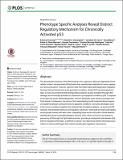Phenotype specific analyses reveal distinct regulatory mechanism for chronically activated p53
Abstract
The downstream functions of the DNA binding tumor suppressor p53 vary depending on the cellular context, and persistent p53 activation has recently been implicated in tumor suppression and senescence. However, genome-wide information about p53-target gene regulation has been derived mostly from acute genotoxic conditions. Using ChIP-seq and expression data, we have found distinct p53 binding profiles between acutely activated (through DNA damage) and chronically activated (in senescent or pro-apoptotic conditions) p53. Compared to the classical ‘acute’ p53 binding profile, ‘chronic’ p53 peaks were closely associated with CpG-islands. Furthermore, the chronic CpG-island binding of p53 conferred distinct expression patterns between senescent and pro-apoptotic conditions. Using the p53 targets seen in the chronic conditions together with external high-throughput datasets, we have built p53 networks that revealed extensive self-regulatory ‘p53 hubs’ where p53 and many p53 targets can physically interact with each other. Integrating these results with public clinical datasets identified the cancer-associated lipogenic enzyme, SCD, which we found to be directly repressed by p53 through the CpG-island promoter, providing a mechanistic link between p53 and the ‘lipogenic phenotype’, a hallmark of cancer. Our data reveal distinct phenotype associations of chronic p53 targets that underlie specific gene regulatory mechanisms.
Citation
Kirschner , K , Samarajiwa , S A , Cairns , J M , Menon , S , Pérez-Mancera , P A , Tomimatsu , K , Bermejo-Rodriguez , C , Ito , Y , Chandra , T , Narita , M , Lyons , S K , Lynch , A G , Kimura , H , Ohbayashi , T , Tavaré , S & Narita , M 2015 , ' Phenotype specific analyses reveal distinct regulatory mechanism for chronically activated p53 ' , PLoS Genetics , vol. 11 , no. 3 , e1005053 . https://doi.org/10.1371/journal.pgen.1005053
Publication
PLoS Genetics
Status
Peer reviewed
ISSN
1553-7390Type
Journal article
Description
This work was supported by the University of Cambridge; Cancer Research UK (C14303/A17197); Hutchison Whampoa. In addition, MasasN and TO were supported by the Human Frontier Science Program (RGY0078/2010); HK was supported by MEXT KAKENHI (Grant Numbers 25116005 and 26291071); KT was supported by the Japan Society for the Promotion of Science (24–8563).Collections
Items in the St Andrews Research Repository are protected by copyright, with all rights reserved, unless otherwise indicated.

